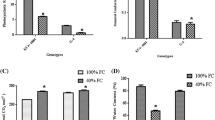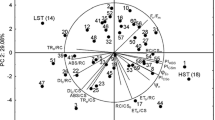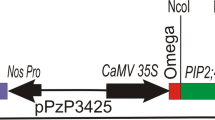Abstract
Aquaporins play an essential role in regulating the water balance in plants. We compared responses between Malus prunifolia (Willd.) Borkh., a reputedly drought-tolerant rootstock, and M. hupehensis Pamp. Reld., which is drought-sensitive. One-year-old seedlings were treated with long-term, moderate water deficit (field capacity of 45–50 %), and were monitored for photosynthetic characteristics, leaf relative water content (LRWC). The relative expressions of mRNA encoding six putative aquaporins also were determined by Q-RT-PCR. Throughout the experimental period, M. prunifolia had higher readings for all four photosynthetic characteristics. Values for LRWC were rapidly reduced under stress, especially for M. hupehensis. Except for TIP2;1, the transcript abundance of most aquaporin genes was elevated after drought stress, reaching a peak at Day 14 before declining in the leaves and roots of both species. For TIP2;1, however, the transcript level was continuously reduced in M. prunifolia leaves throughout the entire course of treatment. Expression of aquaporin genes varied according to the gene, water status, and plant organ being examined. We conclude that Malus aquaporins are responsive to water stress at the transcriptional level, probably playing several roles in conferring drought tolerance. Ours is the first report of this relationship between aquaporins and drought tolerance in Malus species.









Similar content being viewed by others
Abbreviations
- Pn :
-
Net photosynthetic rate
- Tr :
-
Transpiration rate
- Gs :
-
Stomatal conductance
- Ci :
-
Intercellular CO2 concentration
- LRWC:
-
Leaf relative water content
- AQP:
-
Aquaporin
- MIP:
-
Major intrinsic protein
- PIP:
-
Plasma intrinsic protein
- TIP:
-
Tonoplast intrinsic protein
- XIP:
-
X intrinsic protein
References
Aharon R, Shahak Y, Rozalina S, Wininger B, Kapulnik Y, Galili G (2003) Overexpression of a plasma membrane aquaporin in transgenic tobacco improves plant vigor under favorable growth conditions but not under drought or salt stress. Plant Cell 15:439–447
Alexandersson E, Fraysse L, Sjövall-Larsen S, Gustavsson S, Fellert M, Karlsson M, Johanson U, Kjellbom P (2005) Whole gene family expression and drought stress regulation of aquaporins. Plant Mol Biol 59:469–484
Altschul S, Madden T, Schaffer A, Zhang J, Zhang Z, Miller W, Lipman D (1997) Gapped BLAST and PSI-BLAST: a new generation of protein database search programs. Nucl Acids Res 25:3389–3402
Arnold K, Bordoli L, Kopp J, Schwede T (2006) The SWISS-MODEL workspace: a web-based environment for protein structure homology modelling. Bioinformatics 22:195–201
Aroca R, Ferrante A, Vernieri P, Chrispeels MJ (2006) Drought, abscisic acid and transpiration rate effects on the regulation of PIP aquaporin gene expression and abundance in Phaseolus vulgaris plants. Ann Bot 98:1301–1310
Baiges I, Schäffner A, Affenzeller M, Mas A (2002) Plant aquaporins. Physiol Plant 115:175–182
Beitz E, Wu B, Holm L, Schultz J, Zeuthen T (2006) Point mutations in the aromatic/arginine region in aquaporin 1 allow passage of urea, glycerol, ammonia, and protons. Proc Natl Acad Sci USA 103:269–274
Blum A (1996) Crop response to drought and the interpretation of adaptation. Plant Growth Regul 20:135–148
Boursiac Y, Chen S, Luu DT, Sorieul M, van den Dries N, Maurel C (2005) Early effects of salinity on water transport in Arabidopsis roots: molecular and cellular features of aquaporin expression. Plant Physiol 139:790–805
Chang S, Puryear J, Cairney J (1993) Simple and efficient method for isolating RNA from pine trees. Plant Mol Biol Rep 11:113–116
Chaves M (1991) Effects of water deficits on carbon assimilation. J Exp Bot 42:1–16
Chaves M, Maroco P, Pereira J (2003) Understanding plant responses to drought—from genes to the whole plant. Funct Plant Biol 30:239–264
Cochard H, Venisse JS, Barigah TS, Brunel N, Herbette S, Guilliot A, Tyree MT, Sakr S (2007) Putative role of aquaporins in variable hydraulic conductance of leaves in response to light. Plant Physiol 143:122–133
Danielson J, Johanson U (2008) Unexpected complexity of the aquaporin gene family in the moss Physcomitrella patens. BMC Plant Biol 8:45
Flexas J, Medrano H (2002) Drought-inhibition of photosynthesis in C3 plants: stomatal and non-stomatal limitations revisited. Ann Bot 89:183–189
Forrest K, Bhave M (2008) The PIP and TIP aquaporins in wheat form a large and diverse family with unique gene structures and functionally important features. Funct Integr Genom 8:115–133
Graan T, Boyer J (1990) Very high CO2 partially restores photosynthesis in sunflower at low water potentials. Planta 18:378–384
Guan XG, Su WH, Yi F, Zhang D, Hao F, Zhang HG, Liu YJ, Feng XC, Ma TH (2010) NPA motifs play a key role in plasma membrane targeting of aquaporin-4. IUBMB Life 62:222–226
Gustavsson S, Lebrun AS, Norden K, Chaumont F, Johanson U (2005) A novel plant major intrinsic protein in Physcomitrella patens most similar to bacterial glycerol channels. Plant Physiol 139:287–295
Hachez C, Zelazny E, Chaumont F (2006) Modulating the expression of aquaporin genes in planta: a key to understand their physiological functions? Biochim Biophys Acta 1758:1142–1156
Herppich W, Peckmann K (1997) Responses of gas exchange, photosynthesis, nocturnal acid accumulation and water relations of Aptenia cordifolia to short-term drought and rewatering. J Plant Physiol 150:467–474
Holm L, Klaerke D, Zeuthen T (2004) Aquaporin 6 is permeable to glycerol and urea. Pflug Arch Eur J Phy 448:181–186
Horsefield R, Norden K, Fellert M, Backmark A, Tornroth-Horsefield S, Scheltinga ACT, Kvassman J, Kjellbom P, Johanson U, Neutze R (2008) High-resolution x-ray structure of human aquaporin 5. Proc Natl Acad Sci USA 105:13327–13332
Jahn T, Moller A, Zeuthen L, Holm T, Klaerke L, Mohsin D, Kuhlbrandt B, Schjoerring J (2004) Aquaporin homologues in plants and mammals transport ammonia. FEBS Lett 574:31–36
Jang J, Kim D, Kim Y, Kim J, Kang H (2004) An expression analysis of a gene family encoding plasma membrane aquaporins in response to abiotic stresses in Arabidopsis thaliana. Plant Mol Biol 54:713–725
Johanson U, Karlsson M, Johansson I, Gustavsson S, Sjovall S, Fraysse L, Weig AR, Kjellbom P (2001) The complete set of genes encoding major intrinsic proteins in Arabidopsis provides a framework for a new nomenclature for major intrinsic proteins in plants. Plant Physiol 126:1358–1369
Kaldenhoff R, Kölling A, Richter G (1993) A novel blue light- and abscisic acid-inducible gene of Arabidopsis thaliana encoding an intrinsic membrane protein. Plant Mol Biol 23:1187–1198
Kanechi M, Kunitomo E, Inagaki N, Maekawa S (1995) Water stress effects on ribulose-1,5-bisphosphate carboxylase and its relationship to photosynthesis in sunflower leaves. In: Mathis P (ed) Photosynthesis from light to biosphere. Kluwer, Dordrecht, pp 597–600
Kiefer F, Arnold K, Künzli M, Bordoli L, Schwede T (2009) The SWISS-MODEL repository and associated resources. Nucl Acids Res 37:D387–D392
Kozlowski TT, Pallardy SG (2002) Acclimation and adaptive responses of woody plants to environmental stresses. Bot Rev 68:270–334
Labhilli M, Jouchier P, Gautier M (1995) Characterization of cDNA encoding Triticum duram dehydrins and their expression patterns in cultivars that differ in drought tolerance. Plant Sci 112:219–230
Li C, Wang K (2003) Differences in drought responses of three contrasting Eucalyptus microtheca F Muell populations. For Ecol Manag 179:377–385
Li G, Peng Y, Yu X, Zhang M, Cai W, Sun W, Su W (2008) Transport functions and expression analysis of vacuolar membrane aquaporins in response to various stresses in rice. J Plant Physiol 165:1879–1888
Lian HL, Yu X, Ye Q, Ding XS, Kitagawa Y, Kwak SS, Su WA, Tang ZC (2004) The role of aquaporin RWC3 in drought avoidance in rice. Plant Cell Physiol 45:481–489
Liu L, Ludewig U, Gassert B, Frommer W, Wiren N (2003) Urea transport by nitrogen-regulated tonoplast intrinsic proteins in Arabidopsis. Plant Physiol 133:1220–1228
Livak K, Schmittgen T (2001) Analysis of relative gene expression data using real-time quantitative PCR and the 2−∆∆Ct method. Methods 25:402–408
Loggini B, Scartazza A, Brugnoli E, Navari F (1999) Antioxidative defense system, pigment composition, and photosynthetic efficiency in two wheat cultivars subjected to drought stress. Plant Physiol 119:1091–1099
Ma X, Ma FW, Li CY, Mi YF, Bai TH, Shu HR (2010) Biomass accumulation, allocation, and water-use efficiency in 10 Malus rootstocks under two watering regimes. Agroforest Syst 80:283–294
Mahdieh M, Mostajeran A (2009) Abscisic acid regulates root hydraulic conductance via aquaporin expression modulation in Nicotiana tabacum. J Plant Physiol 166:1993–2003
Maurel C, Kado R, Guern J, Chrispeels M (1993) The vacuolar membrane protein gamma-TIP creates water specific channels in Xenopus oocytes. EMBO J 12:2241–2247
Maurel C, Tacnet F, Güclü J, Guern J, Ripoche P (1997) Purified vesicles of tobacco cell vacuolar and plasma membranes exhibit dramatically different water permeability and water channel activity. Proc Natl Acad Sci USA 94:7103–7108
Morillon R, Catterou M, Sangwan RS, Sangwan BS, Lassalles JP (2001) Brassinolide may control aquaporin activities in Arabidopsis thaliana. Planta 212:190–204
Murata K, Mitsuoka K, Hirai T, Walz T, Agre P, Heymann JB, Engel A, Fujiyoshi Y (2000) Structural determinants of water permeation through aquaporin-1. Nature 407:599–605
Park JH, Saier M Jr (1996) Phylogenetic characterization of the MIP family of transmembrane channel proteins. J Membr Biol 153:171–180
Park W, Scheffler B, Bauer P, Campbell B (2010) Identification of the family of aquaporin genes and their expression in upland cotton (Gossypium hirsutum L.). BMC Plant Biol 10:142
Peitsch M (1995) Protein modeling by E-mail. Biotechnology 13:658–660
Phillips A, Huttly A (1994) Cloning of two gibberellin regulated cDNAs from Arabidopsis thaliana by subtractive hybridization: expression of the tonoplast water channel, γTIP, is increased by GA3. Plant Mol Biol 24:603–615
Sade N, Vinocur BJ, Diber A, Shatil A, Ronen G, Nissan H, Wallach R, Karchi H, Moshelion M (2009) Improving plant stress tolerance and yield production: is the tonoplast aquaporin SlTIP2;2 a key to isohydric to anisohydric conversion? New Phytol 181:651–661
Schwede T, Kopp J, Guex N, Peitsch M (2003) SWISS-MODEL: an automated protein homology-modeling server. Nucl Acids Res 31:3381–3385
Sharp RE, Poroyko V, Hejlek LG (2004) Root growth maintenance during water deficits: physiology to functional genomics. J Exp Bot 55:2343–2351
Smart LB, Moskal WA, Cameron KD, Bennett AB (2001) MIP genes are down-regulated under drought stress in Nicotiana glauca. Plant Cell Physiol 42:686–693
Suga S, Komatsu S, Maeshima M (2002) Aquaporin isoforms responsive to salt and water stresses and phytohormones in radish seedlings. Plant Cell Physiol 43:1229–1237
Sui H, Han BG, Lee JK, Walian P, Jap BK (2001) Structural basis of water-specific transport through the AQP1 water channel. Nature 414:872–878
Tyerman S, Niemietz C, Bramley H (2002) Plant aquaporins: multifunctional water and solute channels with expanding roles. Plant, Cell Environ 25:173–194
Vadell J, Medrano H (1992) Effect of drought on subterranean clover, 2: genetic variability of photosynthesis, transpiration and stomatal conductance. Photosynthetica 27:433–444
Weig A, Deswarte C, Chrispeels MJ (1997) The major intrinsic protein family of Arabidopsis has 23 members that form three distinct groups with functional aquaporins in each group. Plant Physiol 114:550–555
Ye N, Zhai H, Du Z, Xu H (2004) Evaluation of drought resistance of ten apple rootstocks. J Fruit Sci 21(5):395–398 (in Chinese with English summary)
Zardoya R, Villalba S (2001) A phylogenetic framework for the aquaporin family in eukaryotes. J Mol Evol 52:391–404
Zhu C, Schraut D, Hartung W, Schaffner AR (2005) Differential responses of maize MIP genes to salt stress and ABA. J Exp Bot 56:2971–2981
Acknowledgments
This work was supported by the earmarked fund for China Agriculture Research System. The authors are grateful to Priscilla Licht for help in revising our English composition and to Mr. Xuanchang Fu for management of the potted apple plants.
Author information
Authors and Affiliations
Corresponding author
Additional information
Changhai Liu and Chao Li contributed equally to this work.
Rights and permissions
About this article
Cite this article
Liu, C., Li, C., Liang, D. et al. Aquaporin expression in response to water-deficit stress in two Malus species: relationship with physiological status and drought tolerance. Plant Growth Regul 70, 187–197 (2013). https://doi.org/10.1007/s10725-013-9791-x
Received:
Accepted:
Published:
Issue Date:
DOI: https://doi.org/10.1007/s10725-013-9791-x




